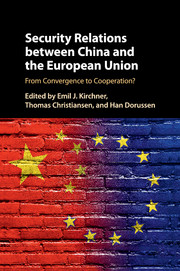Book contents
- Frontmatter
- Dedication
- Contents
- List of Tables
- Preface and Acknowledgements
- Abbreviations
- List of Contributors
- 1 EU–China Security Cooperation in Context
- 2 Chinese and EU Views of Military Security: Crafting Cooperation
- 3 Regional Solutions for Regional Confl icts? The EU, China and their Respective Neighborhoods
- 4 Aims versus Deeds: EU–China Cooperation in Nuclear Nonproliferation
- 5 Terrorism and Organized Crime: Common Concerns but Different Interests
- 6 Chinese and EU Climate and Energy Security Policy
- 7 Competing or Converging Claims on International Order? The EU, China and Human Security
- 8 Civil Protection: Identifying Opportunities for Collaboration
- 9 Cybersecurity and EU–China Relations
- 10 The Economic Security Dimension of the EU–China Relationship: Puzzles and Prospects
- 11 Is Securitizing Migration a Mandatory Choice? Lessons from the EU and China
- 12 Against the Odds: (Considerable) Convergence and (Limited) Cooperation in EU–China Security Relations
- Index
- References
7 - Competing or Converging Claims on International Order? The EU, China and Human Security
Published online by Cambridge University Press: 05 September 2016
- Frontmatter
- Dedication
- Contents
- List of Tables
- Preface and Acknowledgements
- Abbreviations
- List of Contributors
- 1 EU–China Security Cooperation in Context
- 2 Chinese and EU Views of Military Security: Crafting Cooperation
- 3 Regional Solutions for Regional Confl icts? The EU, China and their Respective Neighborhoods
- 4 Aims versus Deeds: EU–China Cooperation in Nuclear Nonproliferation
- 5 Terrorism and Organized Crime: Common Concerns but Different Interests
- 6 Chinese and EU Climate and Energy Security Policy
- 7 Competing or Converging Claims on International Order? The EU, China and Human Security
- 8 Civil Protection: Identifying Opportunities for Collaboration
- 9 Cybersecurity and EU–China Relations
- 10 The Economic Security Dimension of the EU–China Relationship: Puzzles and Prospects
- 11 Is Securitizing Migration a Mandatory Choice? Lessons from the EU and China
- 12 Against the Odds: (Considerable) Convergence and (Limited) Cooperation in EU–China Security Relations
- Index
- References
Summary
Over the past four decades, the European Union (formerly the European Community) and China have maintained an ever-increasing set of bilateral relations of varying degrees of cooperation and conflict (Chen and Armstrong 2010). For the last two decades, as both partners emerged as global security providers, their respective policy agendas have begun to touch upon issues of human security. The concept of human security, hailed alike by pundits and policymakers since the mid-1990s (Gaspers 2005; Fukuda-Parr and Messineo 2012), has thus informed national, bilateral and multilateral policymaking both in the EU and China (Bedeski 2007; Solana 2014; Breslin 2015).
Human security challenges are rooted in two global interrelated processes. First, the crises arising from the steady erosion of modern statehood and responsible government in many parts of the world, which in turn create a diverse set of dangers, risks and threats to human well-being. Following the Cold War, these challenges have multiplied as transnational actors, such as terrorist groups, and transnational occurrences, such as infectious diseases, spread (unevenly) across the globe, probing political authority on all levels: local, national, regional and global (Bajpai 2003; Kaldor 2007). Second, human security is a normative and dynamic concept that arises from the conferral of obligations by normative entrepreneurs on governments to provide (additional) protection and expanded freedoms (Burgess et al. 2007; Gaspers 2009). While Behringer (2005) has argued that “middle powers” were instrumental in pushing the concept, and others have highlighted the impact of various UN agencies (Newman 2014), an intense academic debate ensued as to how far the concept had been “captured” by national governments to pursue their traditional security agenda, thereby sidelining several nontraditional security concerns, such as global health, gender equality and cultural security (Chandler 2008; Owen 2008; Krause 2014).
In the early twenty-first century, considerable differences in content and emphasis of the three key pillars thus remain: freedom from want, freedom from fear and freedom to take action on one's own behalf (UNCHS 2003). To cooperate, however, does not require a formal normative consensus or converging interests between two powers. What is essential, as the example of the emerging norm of “responsibility to protect” attests, is the compatibility of foreign policy behavior by the EU, China, the United States and a few others, which allows for policy coordination in the UN and various other international fora.
- Type
- Chapter
- Information
- Security Relations between China and the European UnionFrom Convergence to Cooperation?, pp. 124 - 144Publisher: Cambridge University PressPrint publication year: 2016
References
- 1
- Cited by



